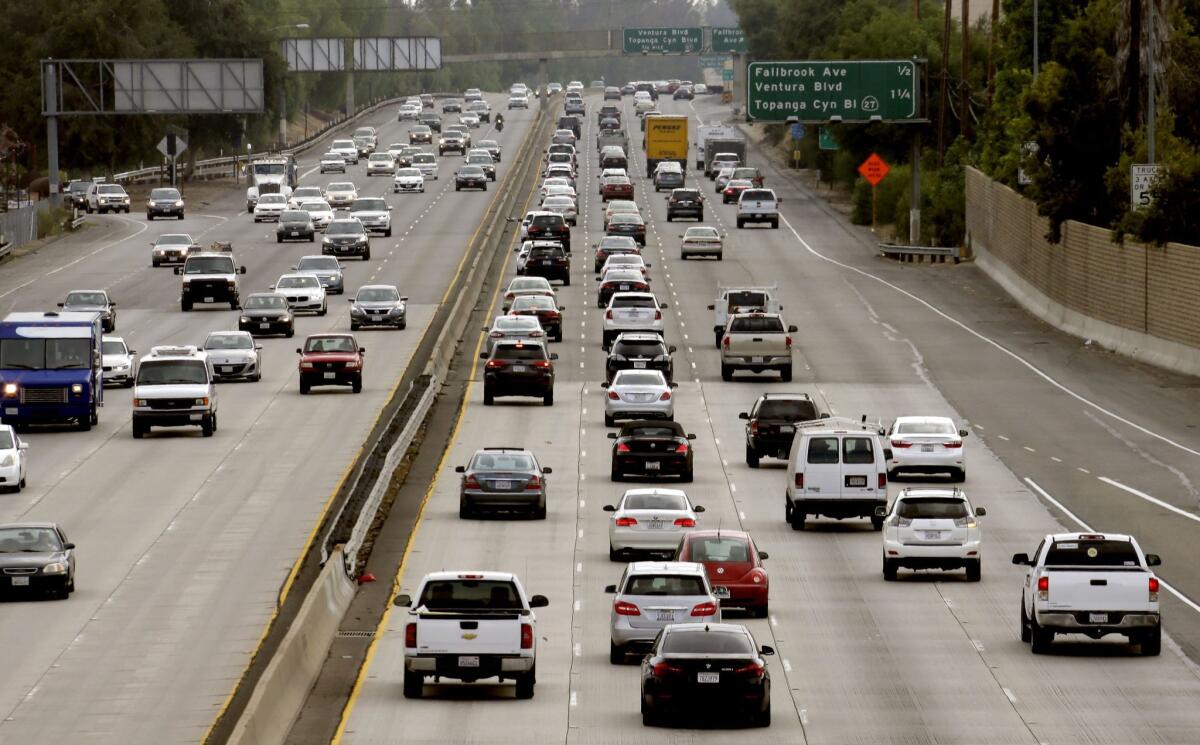California falling short in push for more clean vehicles

Pollution from vehicles remains a problem for California in its attempts to meet strict goals for curbing greenhouse gases.
- Share via
Reporting from Paris — Even as California sells itself as an environmental success story during the United Nations summit here, the state is in danger of failing to meet its own targets for getting clean vehicles on the road.
In a state with sprawling suburbs, stiff traffic and a longtime love affair with the internal combustion engine, slashing the amount of gasoline burned is a tall order. But unless it finds a way, California won’t accomplish the emissions goals it has promoted as a model for the rest of the world.
“Electric cars are growing,” Gov. Jerry Brown said in an interview. “But they’re not ramping up at the level we need.”
The challenge with vehicles is one of the clearest examples of the monumental task of slashing greenhouse gas emissions enough to slow global warming. As Brown often reminds his audiences, they likely arrived at his events by riding in a gasoline-powered car.
“A few people took bikes,” he said in a speech on Tuesday. “Congratulations. That’s not enough.”
In California, the numbers are daunting. Residents drive roughly 330 billion miles per year, burning through 14 billion gallons of gasoline and 4 billion gallons of diesel. Almost 40% of the state’s greenhouse gas emissions come from transportation.
There are about 160,000 zero-emission cars in California, more than anywhere else in the country, but it’s far from enough.
“We’re not currently on a path that will lead us to the 1.5 million,” said California Air Resources Board Chair Mary Nichols in a reference to the 2025 target set by the governor.
However, 1.5 million would need to just be the start -- to reach the state’s 2030 goals for cutting emissions and oil use, Brown said the state would likely need more than 5 million.
“Don’t know how we’re going to get there,” he said. “It’s a very big goal.”
On top of that, state officials just signed an international pledge during the U.N. summit to ensure every new passenger vehicle -- not including buses -- sold in the state by 2050 doesn’t produce any emissions.
The skyrocketing series of targets means Brown and his administration are looking for new policies to get more clean cars on the road, whether they’re powered by hydrogen or electricity. But the governor seemed frustrated by the tools at his disposal to make it happen.
“It seems like the only policy is to put out more incentives, more money,” he said.
Tackling emissions from vehicles has been particularly controversial in the capital. Brown has called for a 50% cut in oil use for transportation by 2030, but industry opposition successfully pressured lawmakers to remove the goal from legislation that would have turned it into law.
However, the measure that was eventually signed by the governor in October creates incentives for utilities to install additional charging stations for electric vehicles. Senate leader Kevin de León (D-Los Angeles), who authored the bill, hopes it will reduce the “range anxiety” felt by drivers who fear an electric car can’t get them where they’re going.
“Charging stations in the near future will be ubiquitous,” he said.
Putting a network in place is a key foundation, said Pasquale Romano, chief executive of ChargePoint, a California company that builds charging stations.
“You have to have some amount of infrastructure that’s visible initially,” he said. In a “chicken or the egg debate,” Romano said, the charging stations are the eggs.
State Sen. Fran Pavley (D-Agoura Hills), who has also authored legislation to reduce vehicle emissions, is hoping for the “guys in a garage” scenario, with young hotshots chasing the Silicon Valley dream by experimenting with stronger batteries.
On Tuesday, Brown cited two other challenges with getting more clean cars on the road. First, the price of oil has dropped, reducing the cost pressure to consider alternatives. Second, there’s a financial hurdle, despite federal and state rebates.
“It costs more to buy an electric car, period,” Brown said. “The cost is the barrier.”
California has other programs to help move the state toward its emissions reductions targets, including rules requiring cleaner gasoline, more renewable energy and more efficient buildings.
But Brown said much more will be needed, both in California and the rest of the world.
“I want you to feel good about the fact that you are here,” the governor told an audience at the United Nations summit. “But I don’t want you to think that we’re even close to a solution.”
He added, “We are really far away. What we have to do, we don’t even know how to do yet.”
Twitter: @chrismegerian
More to Read
Get the L.A. Times Politics newsletter
Deeply reported insights into legislation, politics and policy from Sacramento, Washington and beyond. In your inbox twice per week.
You may occasionally receive promotional content from the Los Angeles Times.











